Riding High: Baan Chang Elephant Park
Posted: October 8th, 2013 | Author: ctbideas | Filed under: ATW Updates | No Comments »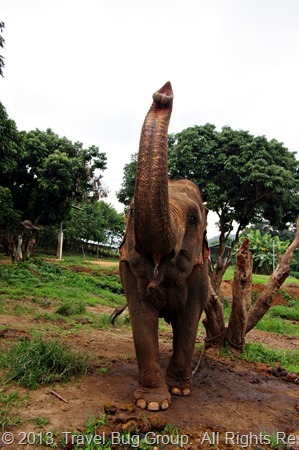
As with many one-day tours & activities here, a driver picks us up directly from the entrance of our guesthouse. We were the only non-whites and only Americans on the one-day tour to Baan Chang Elephant Camp, the others a mix of European tourists. In fact, while conversing during lunch, an Australian girl confided to us that ours in the easiest accent to pick out. Upon arriving at the camp, we were immediately treated with a field dotted with humongous elephants, and a shed piled high with bunches of green bananas. A locker was assigned to each pair and each person was given a set of denim "mahout" clothes. The mahouts, people assigned to care for each elephant on a one-to-one basis, we encountered wore a mix of casual t-shirts, cut-offs, and bandannas, so the clothes we wore weren’t authentic in the slightest. Later on, we learned that not only did the clothes allow us to get down-and-dirty without worrying, the elephants (due to their rather poor eyesight) recognize the clothes, not the mix of people wearing them, and so allow the set of moving clothes to clamber on their back day after day without fuss.
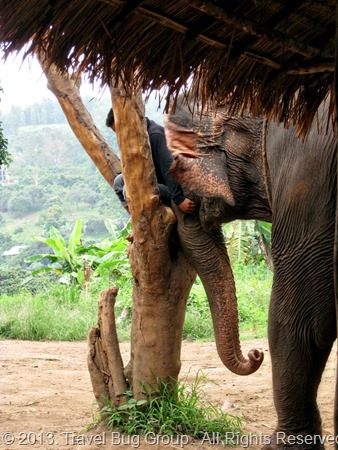
See the good relationship the mahouts have with their elephants?
Before allowed to interact with the elephants, our guide gave us a brief overview of the history and philosophy of Baan Chang. Baan means "home" and Chang means "elephant" in Thai (now I know why Chang beer has a picture of elephants on the front) so Baan Chang Elephant Camp means "Home for Elephants". The owner of the camp didn’t like seeing the way elephants were mistreated or forced, in certain tourist attractions, to do things unnatural for elephants, so at first adopted abused elephants personally. Soon, his endeavor grew too large. In order to subsidize his mission and to educate others about elephants, he started Baan Chang Elephant Park. Our guide seemed a bit on the defensive side, stating that the hooked implements used to control the elephants were not used cruelly, and that the parks that profess to not use anything to control elephants were probably tricking the tourists with blades hidden in their hands. Also, the elephants are kept loosely chained so that they don’t fight each other, and they don’t escape down the street to munch on a neighbor’s farm. Some of the elephants were still not fully socialized or had certain fear of humans so they are kept separately until they’re better.
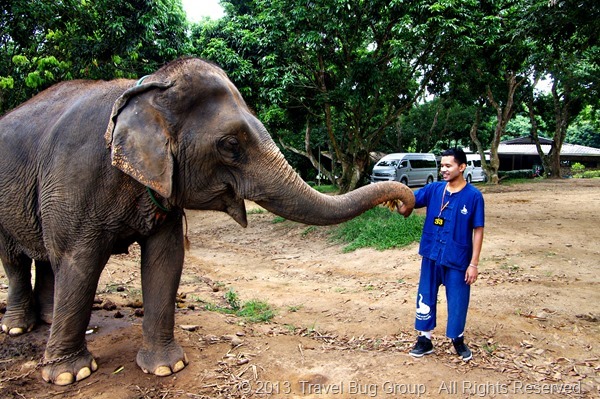

Our first task was to feed the elephants. We were given a basket full of yellow banana bunches and chopped-up stalks of purple sugar cane and directed to spread the wealth equally among all the elephants. The elephants get very excited, sensing they’re about to be fed, and they easily rotate around to face whichever human is lugging a basket nearby them. Just by feeding them, you can already get a sense of the differing personalities among the elephants. Some are impatient, blaring out a loud note if they feel ignored and not getting enough bananas. Some are proactive, curling their trunk around the baskets rim if the humans are preoccupied and dragging it closer. One of our favorites liked being fed, his tongue raised high in the air, triangular lower lip open, thick tongue almost-twitching in anticipation. We would place a whole bunch of bananas in his open mouth. He’d munch for a bit, swallow, then open his mouth for more like a gargantuan baby bird.
Then our guide taught us a few elephant commands in order to "control" our elephants. I put quotation marks around the word "control" because I seriously doubt the elephants are paying the least attention to us, much less to any commands we care to give. Here are some commands we learned:
"Nonlong": Lie Down. The elephant lowers itself down, leaning on one side or another, and we (awkwardly) grasp onto the tops of its ears, and clamber onboard.
"Pai" (accompanied by kicking both its ears from behind): Go Forward.
"Kwey" (accompanied by kicking its right ear to go left & vice versa): Turn.
"How" (accompanied by squeezing both legs): Stop.
Of course, all these commands aren’t automatic. We do the command. The elephant ignores us. The mahouts (secretly) tell them the command. They think about it, chew on a banana leaf, and then, eventually, get around to doing it. The men of the group revel in the commands, firm and strict. The women are more timid, whispering the commands in a questioning tone, and the elephants don’t even twitch an ear in acknowledgement.
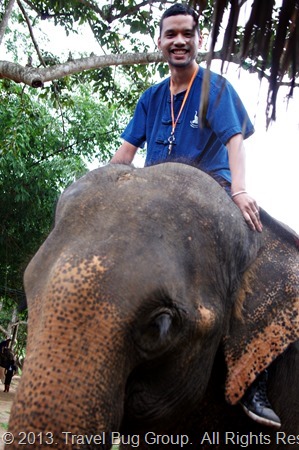
After a delicious meal in which we were harangued into eating not only our portion of fried chicken but another table’s fried chicken also (somebody wasn’t feeling well….aka. hangover) before being allowed dessert, we conversed with another couple from England while the others lazed around in bamboo hammocks. Soon, we were introduced to our own personal elephant, a female named Bon Wat. We started off with Rick being the "driver" (or the one astride her neck) and me being the "passenger" (or the one clinging for dear life on a rope strapped around her broad back). An elephant’s skin is so thick, 2 inches, and slightly rough, like used-up sandpaper, and prickly stiff hairs a few inches long poke up all over her body so that they scrape against your skin through our clothes. She’s also warm, her muscles rhythmic with motion, a sort-of rolling that takes me back to Beginning Salsa Dance class back in college. We take a long round in the jungle and it’s beautiful, the lush green landscape dotted with banana trees and a background of hazy rounded mountaintops. Every so often, right when I get comfortable and slacken my hold on the rope, Bon Wat tackles a new obstacle: mud, steep incline, large puddles, and I go right back to one hand clutching at the rope, my knuckles scraping across her skin, and the other hand reaching out automatically to curl into the fabric of Rick’s shirt as if he could do anything to prevent me falling. In fact, I’d probably pull him right off with me and what a situation that’d be.

We take a break between round 1 and 2, and during the ten minutes, Bon Wat decides to take a dirt bath, returning back from her sojourn in the jungle covered in about an inch of rich dark dirt. I’m the driver this time, and Rick the passenger. When I’m sitting high atop her, my fingers wildly futter about searching for a handhold, but there’s no horn or protrusions I can grip, only the top of her head, and I press down on her warm dirt-encrusted head as if that can somehow ground me. The feel of her head is so strange to me, squishy, and I can’t feel her skull, so I feel as if I’m massaging her brain directly. I’m a bit scared of heights so I try not to look directly down, just forward and up. When I do make the mistake of looking down, I meet the eyes of our mahout, Kwey (like the command), and he smiles back at me in reassurance. This whole time, our guide is running back and forth like a frantic monkey snapping pictures on his small pink point-and-shoot camera. At one point, one of the elephants takes exception to all this scurrying about and sprays him in the face with a trunk-full of muddy water. Our guide glares and shakes his fist in mock-exasperation, but he sighs at the rest of
us saying, "She doesn’t like me. Some elephants are my friend, but others think I am their enemy."
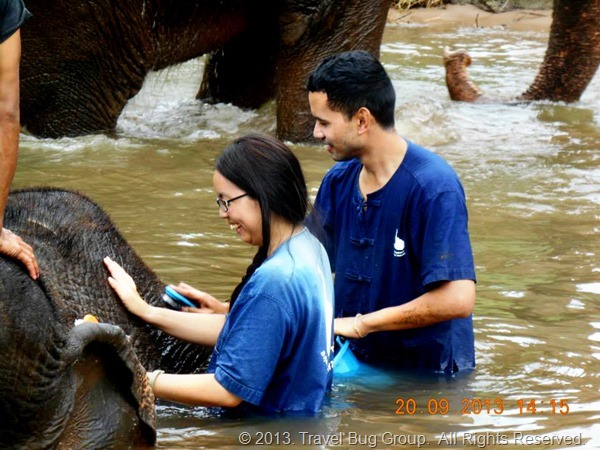
Afterwards, the elephants are led towards a large brown lake and we are handed buckets. Inside the bucket are two scrub brushes. We spend some time scrubbing down our elephants, posing with them, chest-deep in the water. My feet stumble over Bon Wat’s tree-stump legs and I apologize. She only closes her eyes and sinks deeper in the cool water, lifting her trunk free of the water so that she can breathe. After saying our goodbyes to Bon Wat, we’re given towels and directed towards showers. I finish the day with a hot sweet cup of tea, before joining the others on the van back to our guesthouse.
Information:
Baan Chang Elephant Park
Website: They offer a variety of packages, one-day, two-day, and three-day ones where you can stay overnight at the park. The pick-up & drop-off is free, a part of the package.
Price: To share an elephant, we paid 2400 baht/person. To have your own elephant, it’s 4200 baht/person.
Hours: The driver picked us up at around 8am, and returned us at around 4:30pm.
Leave a Reply